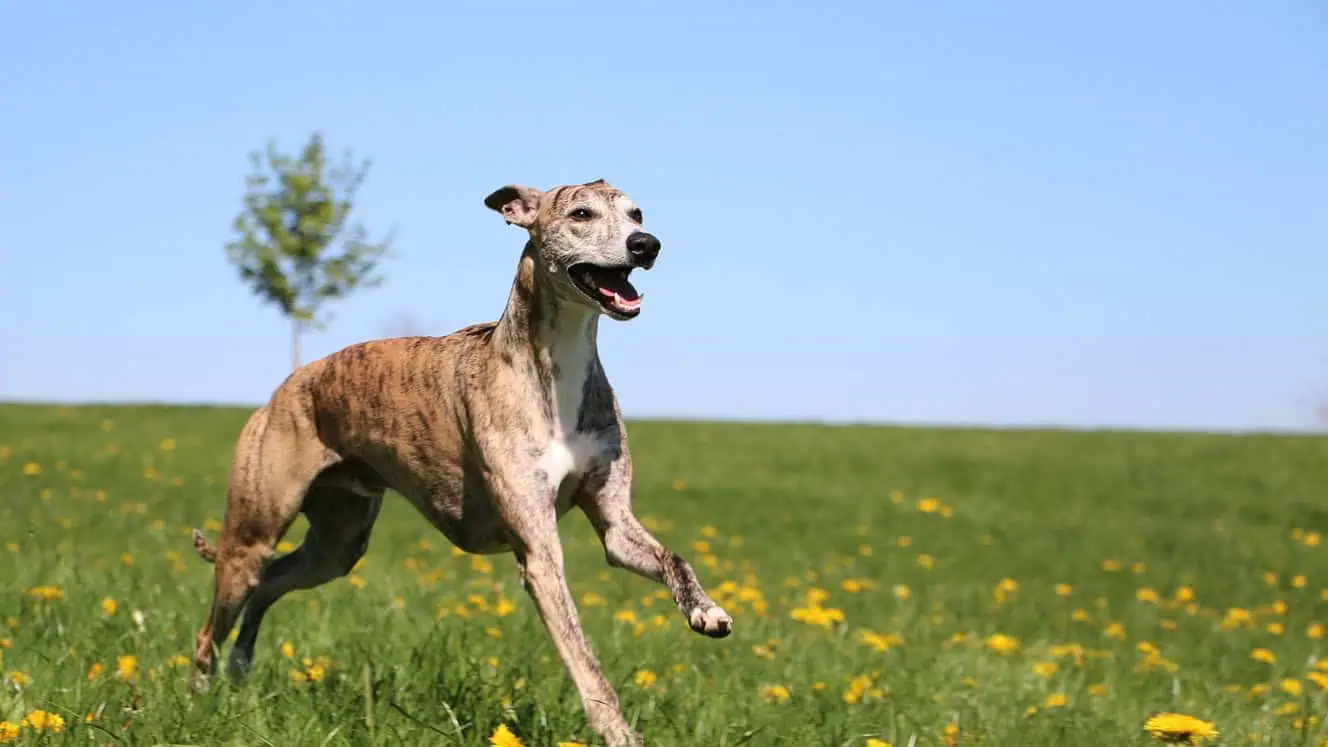The Whippet, often dubbed the “Poor Man’s Racehorse,” is a breed that embodies grace, speed, and affection.
These sleek canines have captivated dog lovers worldwide with their unique blend of athleticism and gentle temperament.
In this guide, we’ll delve deep into the world of Whippets, exploring their history, characteristics, and care requirements.
Whether you’re considering adding a Whippet to your family or simply curious about this fascinating breed, you’re in for a treat!
The Whippet’s Rich History
Whippets have a fascinating backstory that’s as intriguing as their appearance.
These dogs were originally bred in England during the 19th century, primarily by working-class folk who sought a smaller, more manageable version of the Greyhound.
The name “Poor Man’s Racehorse” stems from their popularity among miners and mill workers who used them for rabbit hunting and informal racing events.
From Humble Beginnings to Beloved Companions
Initially, Whippets were created by crossing Greyhounds with smaller terriers and Italian Greyhounds.
This combination resulted in a dog with the Greyhound’s speed and the terrier’s tenacity, all in a more compact package.
Over time, the breed gained recognition beyond the working class, eventually becoming a favorite among all social strata.

Physical Characteristics: Beauty in Motion
Whippets are the epitome of canine elegance.
Their streamlined bodies are built for speed, with a deep chest, tucked-up abdomen, and powerful hindquarters.
Here’s a closer look at their physical traits:
- Height: 18-22 inches at the shoulder
- Weight: 25-40 pounds
- Coat: Short, smooth, and low-maintenance
- Colors: Variety of colors and patterns, including solid, brindle, and parti-color
Fun Fact: Did you know that Whippets can reach speeds of up to 35 miles per hour?
That’s faster than many Olympic sprinters!
Temperament: The Gentle Speedster
Despite their reputation as racing dogs, Whippets have a surprisingly calm and affectionate nature.
They’re often described as having two modes: couch potato and rocket.
Here are some key aspects of the Whippet’s temperament:
- Gentle and loving with family members
- Generally good with children and other dogs
- Can be shy or aloof with strangers
- Low barking tendency, making them suitable for apartment living
- High prey drive due to their hunting heritage
The Whippet Paradox
One of the most fascinating aspects of Whippets is their ability to switch between intense bursts of energy and long periods of relaxation.
As an owner of two Whippets, I’ve often marveled at how quickly they can transition from zooming around the backyard to curling up for a nap on the sofa.
This duality makes them adaptable to various lifestyles, from active outdoor enthusiasts to more sedentary homebodies.
Exercise Needs: Balancing Speed and Rest
While Whippets are known for their incredible speed, they don’t require as much exercise as one might expect.
A typical adult Whippet needs about 30-60 minutes of exercise daily, which can be divided into:
- One or two brisk walks
- A play session in a securely fenced area
- Mental stimulation through puzzle toys or training exercises
Remember, Whippets have a strong prey drive, so always keep them on a leash or in a securely fenced area when outside.

Health Considerations: Keeping Your Whippet in Top Shape
Whippets are generally healthy dogs with a lifespan of 12-15 years.
However, like all breeds, they’re prone to certain health issues. Here are some conditions to be aware of:
- Hip dysplasia
- Eye problems (e.g., progressive retinal atrophy)
- Deafness (particularly in white Whippets)
- Sensitivity to anesthesia
Regular vet check-ups and a balanced diet are crucial for maintaining your Whippet’s health.
Also, be mindful of their thin skin and low body fat, which makes them sensitive to extreme temperatures.
Grooming: Low-Maintenance Beauty
One of the many perks of owning a Whippet is their minimal grooming needs.
Their short, smooth coat requires little more than occasional brushing and bathing.
However, pay special attention to their nails, as they may need regular trimming.
Pro Tip: Use a soft brush or rubber grooming mitt to keep your Whippet’s coat shiny and remove loose hair.
Training Your Whippet: Patience and Positive Reinforcement
Whippets are intelligent dogs, but they can be a bit stubborn at times.
The key to successful training lies in positive reinforcement and consistency. Here are some tips:
- Start socialization early to build confidence
- Use treats and praise as rewards
- Keep training sessions short and fun
- Be patient and avoid harsh corrections
- Consider agility or lure coursing to channel their natural instincts
Remember, every Whippet is unique. What works for one might not work for another, so be prepared to adapt your training methods.

Feeding Your Whippet: Quality Over Quantity
Whippets have a high metabolism but don’t require as much food as you might think.
A high-quality dog food formulated for active breeds is usually sufficient.
Be careful not to overfeed, as Whippets can easily become overweight. Feeding guidelines:
- Puppies: 3-4 small meals per day
- Adults: 2 meals per day
- Seniors: 2 smaller meals per day, adjusted for activity level
Always consult with your veterinarian to determine the best diet for your individual Whippet.
Living with a Whippet: Joys and Challenges
As a Whippet owner, I can attest to the unique joys and challenges of living with these wonderful dogs.
They’re incredibly affectionate and love nothing more than cuddling up with their humans.
However, their strong prey drive means you’ll need to be vigilant when outdoors and ensure your yard is securely fenced.
One of the most endearing traits of Whippets is their adaptability.
They’re just as content lounging on the couch as they are racing around a field.
This makes them suitable for various living situations, from apartments to large homes with yards.
Is a Whippet Right for You?
Before bringing a Whippet into your life, consider the following:
- Do you have time for daily exercise and play?
- Can you provide a secure environment to prevent escapes?
- Are you prepared for a dog that may be shy with strangers?
- Can you commit to 12-15 years of care?
If you answered yes to these questions, a Whippet might be the perfect addition to your family!
In conclusion, Whippets are truly remarkable dogs that offer a unique blend of speed, grace, and affection.
Their low-maintenance grooming needs and adaptable nature make them suitable for many different lifestyles.
While they require understanding and patience, especially when it comes to their prey drive, the love and companionship they offer in return is immeasurable.
Whether you’re looking for a running partner or a couch companion, a Whippet might just be the perfect match for you.
Breed information
| Characteristic | Information |
|---|---|
| Name | Whippet |
| Origin | England |
| Group | Hound Group |
| Size | Medium |
| Height (Male) | 18-22 inches (46-56 cm) |
| Height (Female) | 17-21 inches (43-53 cm) |
| Weight (Male) | 25-40 lbs (11-18 kg) |
| Weight (Female) | 20-35 lbs (9-16 kg) |
| Lifespan | 12-15 years |
| Coat | Short, smooth, and fine |
| Color | Various colors including black, white, blue, fawn, and brindle; can be solid or patterned |
| Temperament | Gentle, affectionate, intelligent, and reserved |
| Energy Level | Moderate to high |
| Exercise Needs | Moderate; enjoys daily walks, running, and playtime |
| Intelligence | High; quick learner and responsive to training |
| Trainability | High; benefits from consistent, positive reinforcement training |
| Grooming Needs | Low; occasional brushing to manage shedding |
| Shedding | Low |
| Health Issues | Potential for health issues such as hip dysplasia, certain heart conditions, and bloat |
| Diet | High-quality dog food; typically 1.5-2.5 cups per day depending on activity level and size |
| Good with Children | Generally good; gentle and playful with children |
| Good with Other Pets | Generally good with other pets if properly socialized |
| Barking | Low; tends to be quiet and reserved |
| Adaptability | Adaptable to various living situations; enjoys companionship and moderate exercise |
| Trainability | High; thrives on positive reinforcement and consistent training |
| AKC Classification | Recognized by the American Kennel Club (AKC) |
Sources:
- American Kennel Club (AKC) – Whippet Breed Information
- The Kennel Club (UK) – Whippet Breed Standard
- Vetstreet – Whippet Overview

















